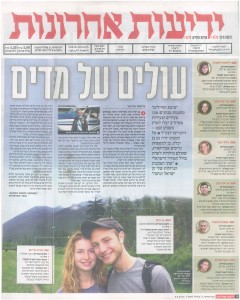A Locavore Harvest of Joy
Are you a locavore?
From June through October, the vast majority of or dinners are 60 percent or more sourced locally—and the majority of that, hyperlocally: either our own garden, or the Next Barn Over CSA farm 3 miles up the road, or the artisan cheeses and breads we buy from area farmers markets. (In a CSA farm, you pay a membership fee and then collect the harvest all season)
Last night’s dinner, about 80 percent locavore, was typical: Of the five different dishes I prepared, four used only local main ingredients (plus very small quantities of non-local flavorings, such as olive oil, salt, and balsamic vinegar):
- Cucumber-tomato-basil soup. All three main ingredients from our garden, plus a touch of hot pepper from the CSA .
- Grilled shitake mushrooms, grown by a friend of ours one town over, and seasoned with herbs from the CSA farm.
- Our own green beans and onions in a nonspicy peanut sauce (locally made one-ingredient natural peanut butter thinned with boiling water—yes, I know, the peanuts, were grown elsewhere, but I ground them myself a couple of days ago, using the store’s machine).
- Organic brown rice (the one nonlocal main ingredient) with our own tomatoes, our own oregano and lavender, the farm’s thyme, and local Greek yogurt.
- Salad with our own cucumbers, the farm’s salad greens and red bell pepper, and a local artisan goat cheese, garnished with non-local walnuts.
I was in a Mediterranean mood, so I used a lot of oregano, thyme, Greek yogurt, and salt. Some meals are more Indian, Chinese, Italian, or Mexican themed, some are a mix—and some have no theme at all.
Eating like this has been remarkably easy, frugal, and infinitely rewarding—I’ll talk more about that tomorrow.
This time of year, our menu planning revolves around what’s in the crisper. I cooked what I cooked because we had two big bags of green beans in the fridge,and one of them was harvested three or four days ago and was not going to last too much longer, by our standards. I’d originally thought I’d make a mixed-veggie dish with our garden broccoli, zucchini, and eggplant—but when I saw the large number of beans that had to be used, I shifted the plan. The rice was left over from Dina’s cooking Thursday night, and we’re still inundated with cucumbers, so I built both the soup and salad around them (all-told, I used eight cukes and four tomatoes plus another seven or so for a batch of frozen sauce I made this morning).
Last night’s feast was a typical meal in the Horowitz/Friedman household. It’s how we eat in the summer and fall. In the winter, we often still manage to eat 30 to 50 percent locavore, drawing heavily on what we’ve frozen and dried during the harvest.
It’s still August, and our freezer is already crammed with corn, kale, green beans, three kinds of our own berries, tomato sauce, garlic scapes, basil pesto, and I forget what all else, and our pantry is lined with jars of dried zucchini and tomatoes—all of it local and organic, and processed while still very fresh.
Growing up in New York City apartment buildings in the 1960s and 70s, “locavore” was an unknown concept. The “fresh” vegetables we ate were trucked from California and had been sitting for weeks and most of our my friends ate their veggies out of cans. So the way I eat is a radical departure from the way I ate as a child. I knew ONE family with a garden: friends of my mother who lived in suburban Westchester County.
Tomorrow, please check back—we’ll look at the impact of eating locally and organic—how being a locavore is good for you, your wallet, and the planet.

